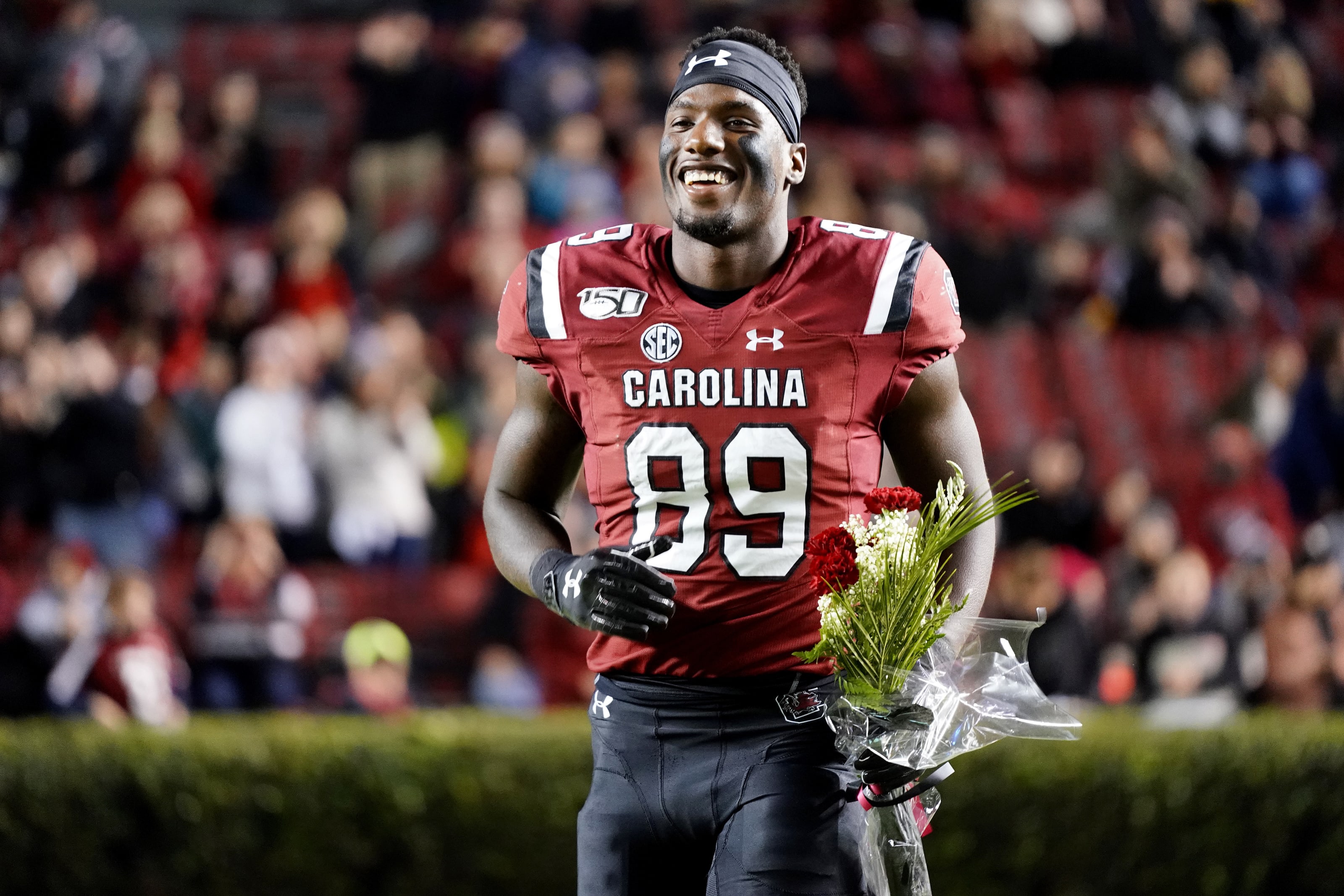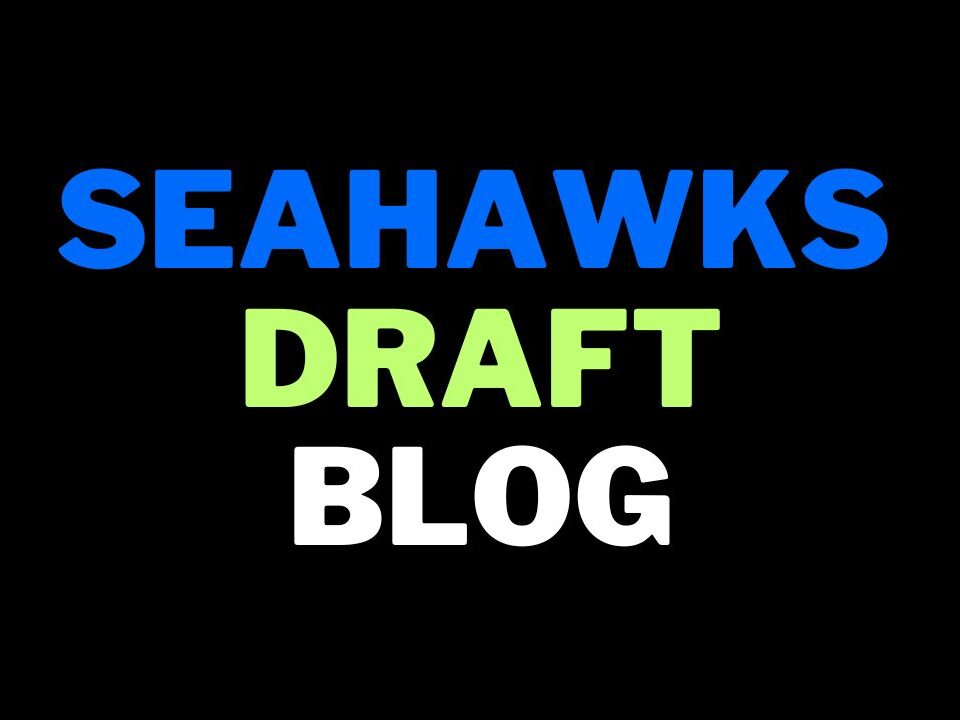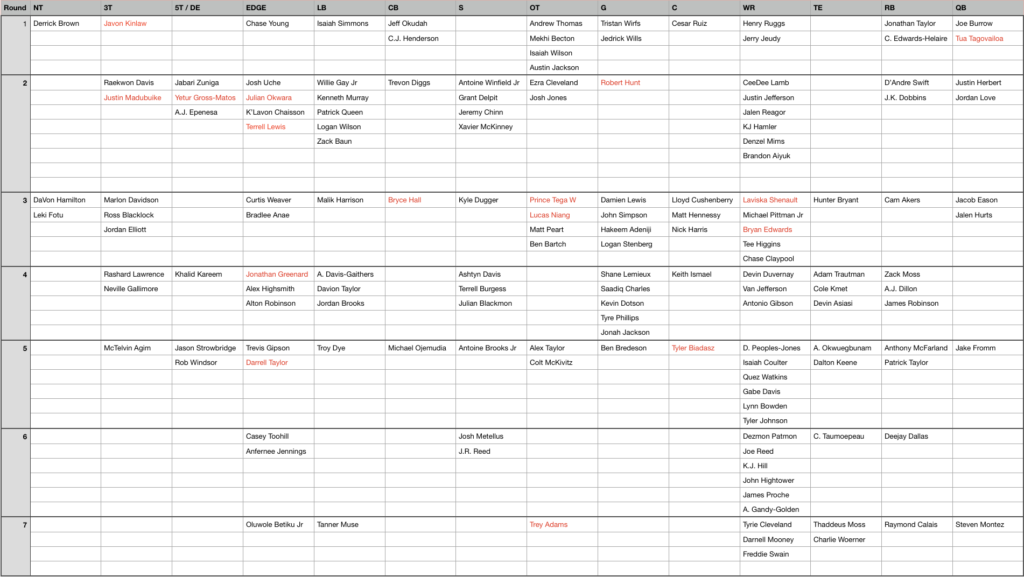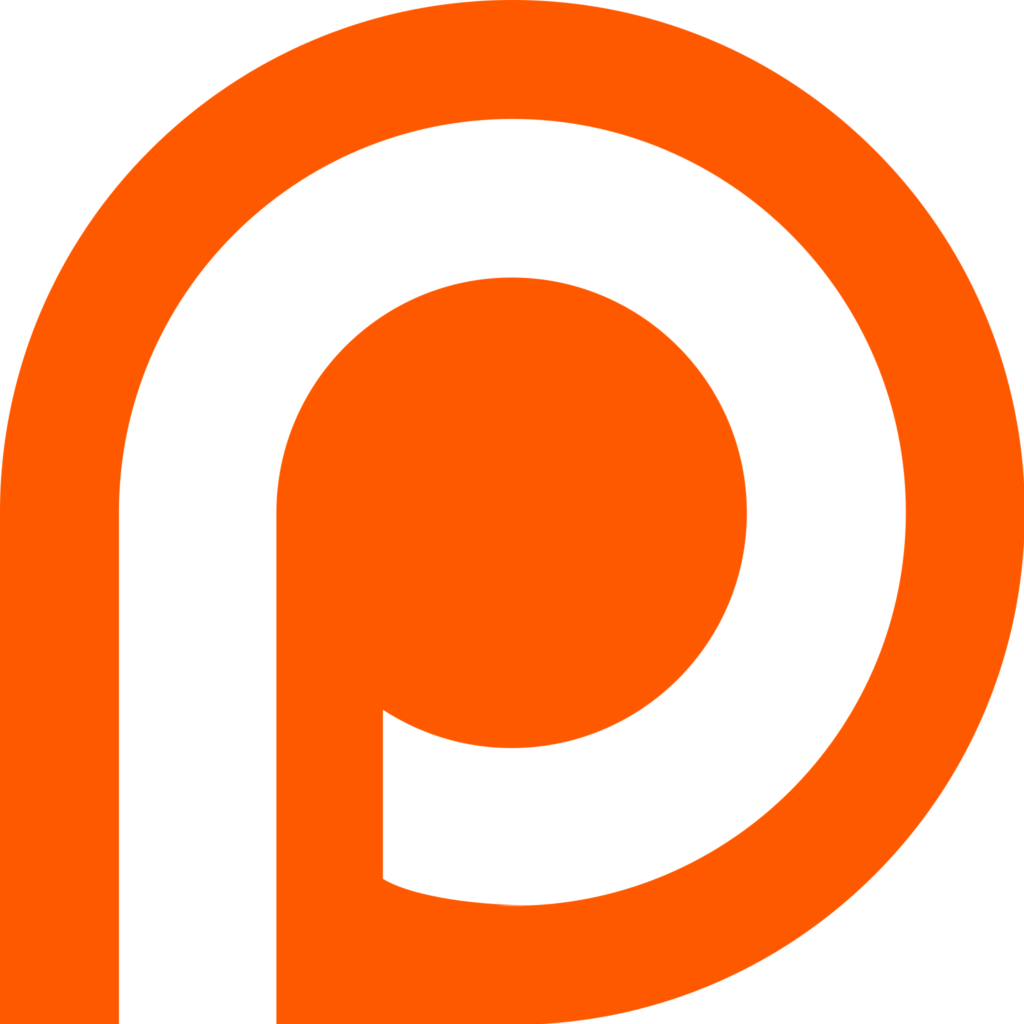
Bryan Edwards broke receiving records at South Carolina
I wanted to represent a few different things in this projection. Firstly — a determination to address the trenches early and add a receiver (tapping into the strength of the draft). I wanted to move down from #27 and move up from #59. The Seahawks do things differently and I also wanted to show that.
#27 — trade down
I have the Seahawks trading down twice. The first move takes them into the 30’s. The second trade moves them into the early 40’s. They’ve done this a couple of times — in 2014 (moving from #32 to #45) and 2019 (moving from #21 to #47). Tony Pauline told us the Seahawks see little difference in quality between the players in the middle part of round one and the middle part of round three. I think they’ll use #27 to create assets to move around later on and collect a larger number of players in their target area. In this scenario they turn #27 into #43, #70 and #196.
#43 — Robert Hunt (T, Louisiana-Lafayette)
The Seahawks rarely take a player the mainstream media has tipped. They identify ‘their guys’. Hunt ticks a lot of boxes. He’s a dominant run blocker with great size (6-5, 323lbs) and physicality. He’s faced football adversity — playing for a High School team that often played with only 11-13 players and then going to a smaller school and succeeding — helping the Ragin’ Cajuns consistently grade well in run blocking and pass blocking per PFF. He’s capable of playing four positions on the O-line. He’s intelligent, determined and would fit the culture perfectly. Some believe Hunt would’ve worked his way into the first round had he been able to compete at the Senior Bowl. He’s one of the toughest, most physical players in the draft and could immediately compete to start at right tackle.
#59 — trade up
Having traded down from #27 to #43, the Seahawks acquired additional stock to move up in round two. They’ve done this before too — going from #56 to #49 to get Jarran Reed in 2016 and a year ago going from #77 to #64 for D.K. Metcalf. They also traded up in round three for Tyler Lockett in 2015. If an opportunity arises to go and get one of the top receivers or running backs in this draft with a small move up the board — or a pass rusher — it could be considered. In this scenario I have them moving up six spots to #53 — giving up #144 (fourth round comp pick).
#53 — Bryan Edwards (WR, South Carolina)
Edwards is a player we originally highlighted at the turn of the year and although he’s lost momentum due to injury, he’s still immensely talented. He broke records at South Carolina with 234 career receptions, 3045 yards and 22 touchdowns. He showed he can win against elite prospects including C.J. Henderson. He can get downfield but he’s also strong on screens and with YAC. He returned punts. People assume he wouldn’t have tested that well and yet at SPARQ he ran a 4.53, jumped a 38 inch vertical and ran a 4.31 short shuttle. His interviews are also very impressive. He’s mature, determined and he’d fit the culture in Seattle. Edwards would be the ideal compliment to the receivers already on Seattle’s roster. Would they need to move up and get him? Possibly so. It’ll be interesting to see which receivers last into this kind of range. Chase Claypool and K.J. Hamler could also be options — but I think Claypool could easily go to New England or Baltimore in the late first.
#64 — DaVon Hamilton (DT, Ohio State)
Will the Seahawks wait until their third pick to address their biggest need? It’s entirely possible they go after someone like Josh Uche right off the bat to add some pass rush, or select a defensive tackle earlier. However — this is very much an offensive tackle and receiver draft early. Let’s see if the Seahawks sign a veteran pass rusher before Thursday too. Seattle will draft a defensive tackle from this class and I think it’ll be an Al Woods replacement. Someone with size and physicality. Leki Fotu is a clear alternative a bit later on. Hamilton just offers a more complete game. He’s 6-4 and 320lbs with 33 inch arms and he anchors the interior as you’d expect at that size. He also had 10.5 TFL’s in 2019, six sacks and his pass rush win percentage (12.6%) is the same as Ross Blacklock’s at 290lbs and is superior to Jeffery Simmons (11.8%) and Ed Oliver (11.4%) from a year ago. Furthermore, his 73% win percentage in 1v1 drills at the Senior Bowl was second only to Zach Baun (75%). We know the Seahawks pay close to attention to the top performers in Mobile.
#70 — trade down
A third and final trade. Having used pick #144 to go and secure Bryan Edwards, the Seahawks move down seven spots to #77 and gain pick #178. They have a few options in this projection — at running back, pass rush and linebacker. So they feel comfortable moving down a few places.
#77 — Darrell Taylor (DE, Tennessee)
I’m not entirely convinced by Taylor. If you collected his top-10 plays from 2019 and put them together in a highlights video, you’d think he was a top-15 pick. When you actually watch the games in their entirety, he’s much less effective with only the occasional flash. Even so, this isn’t a particularly good ‘edge’ rusher draft. All of the prospects have flaws or question marks. This year you have to identify the proper range to take one. You don’t want to go without — but you also don’t want to jump too early when the options are far superior at other positions. Taylor, if nothing else, gives you some upside and potential to harness. He can be dynamic off the edge with a bend-and-straighten only matched in this class by Josh Uche. Unlike Uche, however, he’s 6-3 and 267lbs and at least stands a chance of being a full time DE or LEO. His injury history is a concern but the Seahawks probably need to take some chances. It paid off with Metcalf and it might pay off here. His pass rush win percentage (18.6%) is in the same range as Yetur Gross-Matos (18.9%) and it’s superior to A.J. Epenesa (17.5%) and K’Lavon Chaisson (13.1%).
#101 — Terrell Burgess (S/CB, Utah)
It’s always worth noting the positions Seattle hasn’t addressed going into a draft. This year that’s defensive tackle, running back and nickel cornerback. They could be prioritised more than we think — or they could have some alternative veteran signings (Isaiah Crowell, for example) lined up if the draft goes a certain way. Trying to identify a nickel for Seattle is tough. This is a position where they’ve often made do, traded for a cheap veteran or plucked players from obscurity. There’s no defined physical profile either. Their best nickel has been Justin Coleman — a 4.53 runner with 31 1/4 inch arms who excelled in the short shuttle (3.98) and three cone (6.66). I’ve picked Burgess here for a number of reasons. Firstly, he’s versatile having switched between cornerback and safety. He’s been hailed for his preparation, he does a good job avoiding blocks on screens and perimeter runs (Seattle really needs to be better here), he’s very willing in run support and his tackling is good. He ran a 4.46 at the combine and he has the quickness to play nickel. He had the #2 coverage grade in the slot in the entire draft class last season per PFF. We know the Seahawks like Utah players and it won’t be a surprise if they add Burgess to the competition.
#133 — Tyler Biadasz (C, Wisconsin)
Tony Pauline recently reported there are injury flags with Biadasz and he could suffer a significant fall into round four as a consequence. The Seahawks have been willing to take a chance on players in that position before (see: Jesse Williams). If they part ways with Justin Britt, which remains unclear, they will need a bit more competition at center. Biadasz is a meat and potatoes center who excelled in the running game and he fit the Wisconsin approach to football perfectly. He’ll have limitations in pass pro against the top athletes but in the right offense he can be effective. According to PFF he has the highest percentage of positively graded blocks in the running game over the past three years.
#178 — Joe Reed (WR, Virginia)
The Seahawks need to come away from this draft with at least one legit kick returner. They might draft a receiver early who can contribute there. If not, they might save a pick later on purely for someone with return qualities. As a senior, Reed was named first-team All-ACC as an all-purpose player and return specialist. He scored twice as a returner in 2019 while averaging 33.2 yards per return — tied for second in the FBS nationally. He’s also adept at covering kicks. The Seahawks could easily target Reed earlier than this, purely with the intention of securing his special teams value.
#196 — Teair Tart (DT, Florida International)
He has great length (34 1/4 inch arms) for his size (6-3, 290lbs) and he’d provide something a bit different to the defensive line rotation. More than 35% of his total tackles went for a loss in the last two seasons. He’s a tough, physical defender who loves to hammer quarterbacks and can anchor and play with power despite being a little lighter. His biggest area for improvement is actually as a pass rusher. He’s never blown off the line despite his frame and he’s tough to move even on double teams.
#214 — Michael Warren II (RB, Cincinnati)
In an ideal world you address running back much earlier. It’s a top-heavy class and if there’s an opportunity to get a Jonathan Taylor, Clyde Edwards-Helaire, J.K. Dobbins or Cam Akers you have to consider it. Whether you agree with it or not doesn’t matter — it’s simply a fact that Seattle places a lot of emphasis on their running game and when it goes away, the offense struggles (as it did towards the end of last season). If they’re unable to add one of the top backs in this draft they will almost certainly add a veteran or two. That could mean Isaiah Crowell (linked at the start of free agency) and/or Marshawn Lynch (who appears prepared and ready to return if needed). Even so, they could do with drafting a younger body. Warren II lacks the upside to be anything more than depth and competition but he’s rugged and physical, well sized and he finishes his runs.
The class in full
R2 — Robert Hunt (T)
R2 — Bryan Edwards (WR)
R2 — DaVon Hamilton (DT)
R3 — Darrell Taylor (EDGE)
R3 — Terrell Burgess (Nickel)
R4 — Tyler Biadasz (C)
R5 — Joe Reed (KR)
R6 — Teair Tart (DT)
R6 — Michael Warren II (RB)
Final thoughts
This is only one projection and certainly not a definitive ‘this is exactly how I see it playing out’. We’ve talked about so many different scenarios, so many different players. I could easily see them going running back much earlier, or taking a pass rusher first, or adding another linebacker at some point. We’ve talked about all of the different possibilities by now, looked at so many scenarios. On Monday I will publish a long read on the different positions, what the Seahawks look for and the players who could be targets at each position.
What I like about this projection is it feels very ‘Seahawks’. Going against the grain, seeking ideals and preferences, looking for grit. As long as they sign at least one top veteran pass rusher, this projection addresses their needs. They must add a kick return specialist, a defensive tackle, a nickel cornerback and a running back. They must focus on toughness and physicality and bolster both lines. They need to draft at least one pass rusher.
You can now support Seahawks Draft Blog via Patreon by clicking the tab below.





